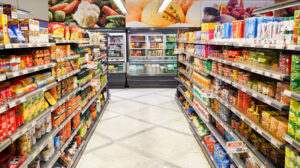Negative inflation was recorded at supermarkets in August, the fourth consecutive month of negative inflation, according to a survey by the Institute for Research on Consumer Goods Retailing (IELKA). Supermarket product prices were recorded down by an average of 1.08% compared to August 2023, with 14 of 23 supermarket product categories recording price reductions.
More specifically, the net decrease in the supermarket chain price trend index in August 2024 shows that supermarket chain inflation is negative at -1.08 (vs. -1.56% in July, -1.92% in June. -1.25% in May, +1.10% in April, +0.28% in March, +2.70% in February and +3.00% in January 2024). According to the survey, the change in August is mainly due to the ongoing price deceleration and partly to the effect of seasonality due to summer.
Largest price declines were recorded in the categories: detergents and cleaning supplies (-6.68%); stationery, cosmetics and toiletries (-5.16%); pet food and supplies (-4.78%); baby and child food (-4.28%); and fresh fruits and vegetables (-2.84%). Fresh fruits and vegetables have benefited from comparatively better weather conditions in early summer compared to 2023. In other species, the decreases recorded are the result of both the normalisation of the market following the pandemic and the reduction in producer prices for some products. Largest increases are recorded in the categories: appetizers, salted and other food preparations (+5.52%), fresh fish and seafood (+5.09%), groceries (+3.51%), biscuits, chocolates, confectionery (+3.41%), alcoholic beverages (+2.07%). Most of these items are affected by seasonal summer demand (e.g. fish, alcoholic beverages) and international raw material prices, sugar and cocoa prices and other production costs. It is noted that of the 23 categories examined, 14 recorded a decrease and 9 an increase.
According to IELKA, the reasons for the trend of restraint in supermarket product prices are:
– Gradual deceleration of inflation. Prices have been declining in recent months in large grocery stores due to the large volumes of products they handle, economies of scale, their organizational/technological readiness and the range of private label products.
-The evolution of commodity prices in the past months in international markets and market normalization. International food commodity indices (e.g. FAO Food Price Index) record a decline in the first months of 2024 in most cases. In cases such as coffee and cocoa, however, the effect is reversed.
– Better weather conditions in 2024 compared to 2023 and seasonality. Last year’s rains had significantly increased costs in fresh fruits and vegetables. At the same time, seasonality in the category’s products is having a greater impact on the overall index.
– Governmental institutional interventions. Supermarket chains operate within a strict institutional framework (e.g. ban on promotional actions in case of price increases 6969/2024).
– Offers and discounts. Offers and discounts in the organised retail channel are more in number, intensity and percentage discount, which affects the final prices of products.
– High inventory turnover rate. Price containment occurs much faster in large retail outlets due to higher inventory turnover rate. That is, they move their stock faster and make new purchases sooner to replenish stock.
– Effect of private label products. Sales shares of private label products are higher in large supermarket chains due to a wider range of code ranges, and have been increasing over the last two years.
Ask me anything
Explore related questions





